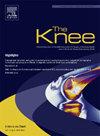Individualized total knee arthroplasty achieves better functional results than off-the-shelf implants in patients undergoing personalized coronal alignment
IF 1.6
4区 医学
Q3 ORTHOPEDICS
引用次数: 0
Abstract
Background
Several studies have demonstrated the interest in patient-specific custom cutting guides in total knee arthroplasty (TKA), but clinical improvement remains debated. The purpose of this study was to evaluate the functional outcomes (Forgotten Joint Score, FJS) of patients undergoing individualized TKA compared with those receiving off-the-shelf (OTS) implants, both using patient-specific cutting guides with personalized alignment over a minimum follow up period of 12 months. We hypothesized that individualized TKA demonstrates significantly better functional outcomes than OTS TKA (FJS and percentage of patients reaching the minimum clinically important difference).
Methods
A continuous single-surgeon retrospective series was analyzed from September 2018 to June 2020. The inclusion criterion was primary TKA for osteoarthritis. The series compared 58 individualized TKAs to 54 standard implants, with personalized alignment, at a mean follow up of 25 (12–40) months. The two groups were comparable in gender, age, BMI, and preoperative deformity. Complications and revision procedures were recorded. The FJS, New IKS, and Oxford Knee Score were assessed at the last follow up, and the sensation of a forgotten knee was evaluated.
Results
One patient in each group required TKA revision. At last follow up, the individualized TKA group showed significantly better FJS (91 ± 14 vs. 81 ± 23, P = 0.01), satisfaction category in the IKS (36 ± 5 vs. 32 ± 8, P = 0.002), IKS function (83 ± 11 vs. 72 ± 21, P = 0.003) and Oxford scores (44 ± 5 vs. 39 ± 10, P = 0.005. There was no significant difference in the IKS objective score (88 ± 16 vs. 82 ± 2, P = 0.34). The sensation of a forgotten knee rate did not differ significantly between the groups.
Conclusion
Individualized TKA leads to improved clinical outcomes significantly compared with OTS TKA, utilizing personalized alignment and patient-specific cutting guides. This combination of personalized factors and individualized TKA enhances the potential to tackle the challenges associated with TKA and improve functional results.
求助全文
约1分钟内获得全文
求助全文
来源期刊

Knee
医学-外科
CiteScore
3.80
自引率
5.30%
发文量
171
审稿时长
6 months
期刊介绍:
The Knee is an international journal publishing studies on the clinical treatment and fundamental biomechanical characteristics of this joint. The aim of the journal is to provide a vehicle relevant to surgeons, biomedical engineers, imaging specialists, materials scientists, rehabilitation personnel and all those with an interest in the knee.
The topics covered include, but are not limited to:
• Anatomy, physiology, morphology and biochemistry;
• Biomechanical studies;
• Advances in the development of prosthetic, orthotic and augmentation devices;
• Imaging and diagnostic techniques;
• Pathology;
• Trauma;
• Surgery;
• Rehabilitation.
 求助内容:
求助内容: 应助结果提醒方式:
应助结果提醒方式:


